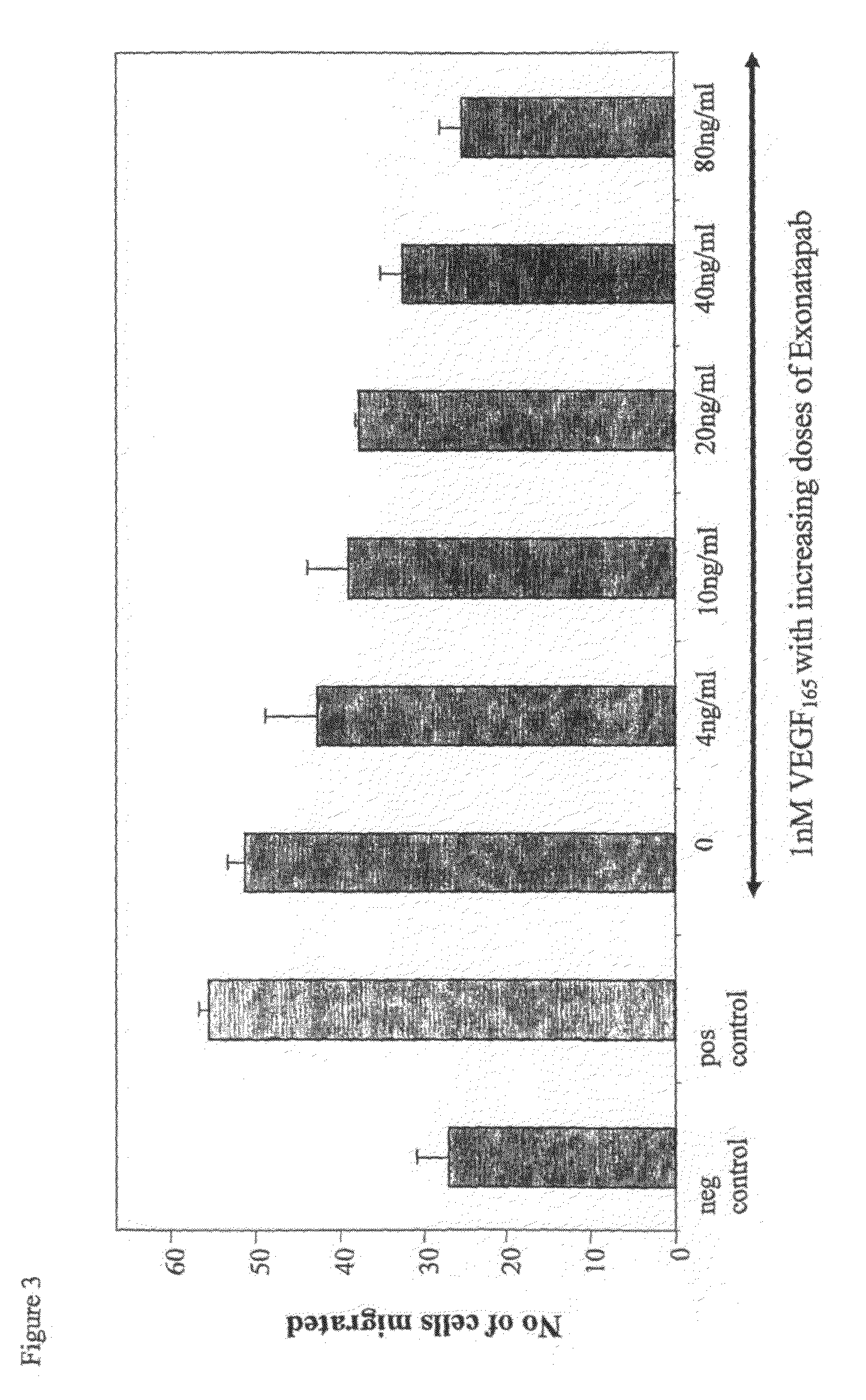Antibodies specific to pro-angiogenic isoforms of vascular endothelial growth factor (VEGF)
a growth factor and pro-angiogenic technology, applied in the field of antibodies specific to pro-angiogenic isoforms of vascular endothelial growth factor, can solve problems such as rate-limiting steps, and achieve the effect of attenuating damag
- Summary
- Abstract
- Description
- Claims
- Application Information
AI Technical Summary
Benefits of technology
Problems solved by technology
Method used
Image
Examples
example 1
[0144]Polyclonal antibodies are preferably raised in animals by multiple subcutaneous (sc) or intraperitoneal (ip) injections of the relevant antigen and an adjuvant. It may be useful to conjugate the relevant antigen to a protein that is immunogenic in the species to be immunized, e.g., keyhole limpet hemocyanin (KLH), serum albumin, bovine thyroglobulin, or soybean trypsin inhibitor using a bifunctional or derivatizing agent, for example, maleimidobenzoyl sulfosuccinimide ester (conjugation through cysteine residues), N-hydroxysuccinimide (through lysine residues), glutaraldehyde, succinic anhydride, SOCl2, or R1N═C═NR, where R and R1 are different alkyl groups.
[0145]Animals are immunized against the antigen, immunogenic conjugates, or derivatives by combining, e.g., 100 μg or 5 μg of the protein or conjugate (for rabbits or mice, respectively) with 3 volumes of Freund's complete adjuvant and injecting the solution intradermally at multiple sites. One month la...
example 2
Production of Specific Polyclonal Antibodies Against VEGF165
[0146]Polyclonal antibodies were designed to bind and inhibit the pro-angiogenic isoform VEGF165 but not the anti-angiogenic form VEGF165b. The peptide RCDKPRR (SEQ ID NO:3), containing the seven C-terminal amino acid residues of VEGF165 was coupled to KLH, through an amino hexanoic acid spacer, and used for immunizing rabbits. Sera containing polyclonal antibodies collected from the immunized rabbits.
Preparation of Peptide-KLH Conjugates for Immunization
[0147]Peptide thiol groups were checked before coupling, either to KLH or to resin, since peptide thiol groups have a tendency to get lost after synthesis.[0148]1. A solution of 5 mM Ellman's reagent (dithio-bis-2-nitrobenzoic acid) in 0.1M NaPi pH 7.2 was prepared.[0149]2. About 1 mg of peptide was weighted into a tared tube.[0150]3. 0.5 ml reagent was added. The solution turned into bright yellow.[0151]4. The mixture was diluted 1 / 50 in buffer. The absorption at 412 nm w...
example 3
Polyclonal Antibodies Against VEGF165 Inhibit Endothelial Cell Migration
[0172]Inhibition of migration was tested as described in Bates et al., Cancer Research 2002, 62, 4123-4131. The assays were performed in a modified 24-well Boyden chamber containing collagen-coated polycarbonate filter inserts (8 m pore; Millipore). The filters were placed in 24-well plates containing 0.5 ml / well of VEGF isoforms with or without 4-80 ng / ml purified antibody fraction. Human Umbilical Vein Endothelial Cells (HUVECs) were suspended in serum-free medium, and 25,000 cells were added to the upper chamber of each well. The plate was incubated for 6 h to allow migration, medium was removed, and both chambers were washed twice with PBS. 0.2 mg / ml thiazolyl blue (MTT) in medium was then added to both chambers and incubated for 3 h at 37° C. The medium was removed, and the chambers were washed twice with PBS. Non-migrated cell crystals in the upper chamber (stained blue) were removed with a cotton swab, wh...
PUM
| Property | Measurement | Unit |
|---|---|---|
| size | aaaaa | aaaaa |
| weight | aaaaa | aaaaa |
| weight | aaaaa | aaaaa |
Abstract
Description
Claims
Application Information
 Login to View More
Login to View More - R&D
- Intellectual Property
- Life Sciences
- Materials
- Tech Scout
- Unparalleled Data Quality
- Higher Quality Content
- 60% Fewer Hallucinations
Browse by: Latest US Patents, China's latest patents, Technical Efficacy Thesaurus, Application Domain, Technology Topic, Popular Technical Reports.
© 2025 PatSnap. All rights reserved.Legal|Privacy policy|Modern Slavery Act Transparency Statement|Sitemap|About US| Contact US: help@patsnap.com



